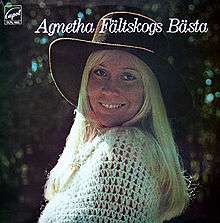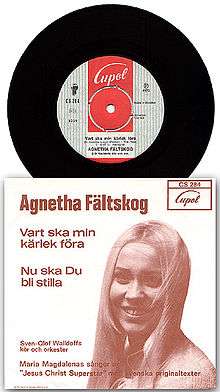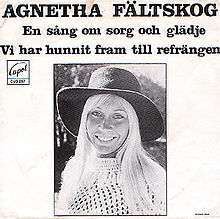Agnetha Fältskogs bästa
| Agnetha Fältskogs Bästa | ||||
|---|---|---|---|---|
 | ||||
| Greatest hits album by Agnetha Fältskog | ||||
| Released | 1973 | |||
| Recorded | 1967–1973 | |||
| Genre | Pop | |||
| Length | 36:08 | |||
| Label | CBS Cupol | |||
| Producer | Karl Gerhard Lundkvist, Björn Ulvaeus, Agnetha Fältskog | |||
| Agnetha Fältskog chronology | ||||
| ||||
| Singles from Agnetha Fältskogs Bästa | ||||
|
||||
Agnetha Fältskogs Bästa (Agnetha Fältskog's Best) is a compilation album by the Swedish pop singer and ABBA member Agnetha Fältskog. It was released in 1973 through CBS Cupol.
Album information
To fill the gap between her last album När en vacker tanke blir en sång, dating back to 1971, and the next album which would eventually be called Elva kvinnor i ett hus and released in late 1975, Agnetha Fältskogs Bästa was released at the end of 1973. Because of the unexpected success of the quartet Björn, Benny, Agnetha & Frida in 1973, and the following year's victory in the Eurovision Song Contest with "Waterloo", the release of her next Swedish-language studio album was delayed until late 1975.
The album included many of her biggest hits from all her four previously released studio albums, starting with her breakthrough single "Jag var så kär", dating back to 1967. Out of the eleven songs included, ten had reached the top 10 of the important Swedish radio chart Svensktoppen. Despite her tight schedule with the group that would eventually be named ABBA (1973 saw them promoting the Ring Ring album as well as recording the Waterloo LP), Fältskog nevertheless managed to record two new songs for Agnetha Fältskogs Basta: "En sång om sorg och glädje" and "Vi har hunnit fram till refrängen", a cover of "Our Last Song Together" by Neil Sedaka. Both would also be released on single, with "En sång om sorg och glädje" appearing on the A-side and also topping the Svensktoppen charts in late 1973 and early 1974. The recording session of those two tracks marked the first time that Fältskog produced her own recordings, a job which she enjoyed and eventually repeated on all of her future Swedish-language recordings.[1]
Track listing
| Side one | |||||
|---|---|---|---|---|---|
| No. | Title | Lyrics | Music | Year; Album source | Length |
| 1. | "Jag var så kär" | Agnetha Fältskog | Fältskog | 1967; Agnetha Fältskog | 3:19 |
| 2. | "Utan dej mitt liv går vidare" | Fältskog | Fältskog | 1968; Agnetha Fältskog | 2:48 |
| 3. | "Allting har förändrat sej" | Karl Gerhard Lundkvist | Karl Gerhard Lundkvist | 1968; Agnetha Fältskog | 3:10 |
| 4. | "Zigenarvän" | Bengt Haslum | Fältskog | 1969; Agnetha Fältskog Vol. 2 | 2:56 |
| 5. | "Om tårar vore guld" | Fältskog | Fältskog | 1970; Som jag är | 3:30 |
Total length: |
15:48 | ||||
| Side two | |||||
|---|---|---|---|---|---|
| No. | Title | Lyrics | Music | Year; Album source | Length |
| 1. | "Många gånger än" | Peter Himmelstrand | Fältskog | 1971; När en vacker tanke blir en sång | 2:37 |
| 2. | "Dröm är dröm, och saga saga" (Swedish version of "Ero bello il mio ragazzo") | Stig Anderson | Gianluigi Guarnieri, Pier Paolo Preti | 1971; När en vacker tanke blir en sång | 3:24 |
| 3. | "Vart ska min kärlek föra" (Swedish version of "I Don't Know How to Love Him") | Britt G. Hallqvist | Andrew Lloyd Webber | 1972; single only | 3:21 |
| 4. | "Så glad som dina ögon" | Kenneth Gärdestad | Fältskog | 1972; single only | 3:01 |
| 5. | "En sång om sorg och glädje" (Swedish version of "Union Silver" (Middle of the Road's hit)) | Anderson | Mario Capuano, Giosy Capuna | 1973; previously unreleased | 3:50 |
| 6. | "Vi har hunnit fram till refrängen" (Swedish version of "Our Last Song Together") | Anderson | Neil Sedaka, Howard Greenfield | 1973; previously unreleased | 4:08 |
Total length: |
20:23 | ||||
Singles

Accompanying the release of Fältskog's first greatest hits album, two newly recorded tracks were released on single in late 1973. Besides that, the album also features two recordings from 1972 which were only released on single and cannot be found on any of Fältskogs studio albums. The first of those, "Vart ska min kärlek föra", is a Swedish version of "I Don't Know How to Love Him", originally from Andrew Lloyd Webber's hit musical Jesus Christ Superstar. Fältskog played the role of Maria Magdalena in the Swedish version of the musical, which opened in Gothenburg in February 1972. Fältskog's Swedish version, produced by Björn Ulvaeus, became her first number 1 hit on Svensktoppen.
| Release date | A-side | B-side | Label number | Swedish charts peak |
|---|---|---|---|---|
| March 1972 | Vart ska min kärlek föra | Nu ska du bli stilla | CS 284 | |
| November 1972 | Så glad som dina ögon | Tio mil kvar till Korpilombolo | CS 291 | |
| November 1973 | En sång om sorg och glädje | Vi har hunnit fram till refrängen | CS 297 | |

Svensktoppen
As mentioned above, Agnetha Fältskogs Bästa includes her first ever number 1 hit on Svensktoppen, "Vart ska min kärlek föra". Besides that, also the newly recorded "En sång om sorg och glädje" managed to top this chart for a total of seven weeks in the last weeks of 1973 and in early 1974. Staying on the chart for 14 weeks, it became one of her most successful hits.[2]
| Chart entry | Title | Peak position | Time in (weeks) |
|---|---|---|---|
| 23 March 1972 | Vart ska min kärlek föra | | |
| 10 December 1972 | Så glad som dina ögon | | |
| 18 November 1973 | En sång om sorg och glädje | | |
References
- booklet, Agnetha Fältskog: Agnetha Fältskog De Första Åren
- Bright Lights Dark Shadows – The Real Story Of ABBA by Carl Magnus Palm
- http://www.agnetha.net/AGNETHA.html
- ↑ De första åren, box set, booklet. Retrieved on 31 May 2011.
- ↑ Svensktoppen archiv. http://sverigesradio.se/sida/artikel.aspx?programid=2023&artikel=454888. Retrieved on 31 May 2011.